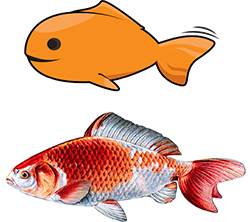
Illustrated by: James Baxter
Sometimes when we only look at a plant or animal we miss seeing some of their amazing parts and how they are constructed. The story of the Invisible Watery World shows that there are tiny living things that come in many shapes and sizes. In lakes, streams and oceans there are plankton. These are small and often microscopic organisms.
This activity will have you exploring the tiny watery world of plankton using only a piece of paper and a pencil. You will be drawing plankton in the Zoom Gallery. Scientific sketching is a skill that has been used by scientists for hundreds of years to draw realistic pictures of organisms. They do this so they can use their sketches to identify new species and communicate information.
Today we have cameras that we use to take pictures of organisms, so why do scientists still make a scientific sketch? Sketches require scientists to focus on details and make keen observations that can be overlooked when taking a picture. It also allows them to detail particular areas or structures that are of interest. In this activity, you will also learn about scale bars and use this information to sketch each variety of plankton in proportion to the others.
What You Need
- Plankton Zoom Gallery
- 1 sheet of white printer paper
- Pencil
*Optional: Sample of pond water and microscope
Procedure
Step 1: Take the sheet of white printer paper and fold it in half lengthwise, and then in half again so you have 4 squares. You will make one sketch inside each square.

 Step 2: Choose 4 different plankton varieties from the Zoom Gallery to draw.
Step 2: Choose 4 different plankton varieties from the Zoom Gallery to draw.
There are many varieties to choose from. Try to pick plankton that you have not seen before. This will challenge you to look at them in detail and draw what you see.
For example, we all have a basic idea of what a goldfish looks like, but in a cartoonish kind of way. Your goal is to draw the plankton as realistically as possible.
 Step 3: Before you begin to sketch the first variety of plankton you need to determine how big to draw it.
Step 3: Before you begin to sketch the first variety of plankton you need to determine how big to draw it.
The white lines on each image on the Zoom Gallery are called scale bars and are equal to 50 micrometers. You will be sketching the plankton magnified and can use the scale bars to find out what size to draw each variety on your paper.
Think about a Labrador retriever and a Chihuahua. Both are dogs, but are very different sizes. If you were to sketch both on the same piece of paper you would not draw them the same size, because the Labrador is much larger than the Chihuahua!
You will apply this idea to the plankton in the Zoom Gallery. Use the scale bars on the on the images to figure out what size to sketch each variety of plankton so that they are in proportion to each other.
Step 4: Select one plankton variety to start. Think about the following questions.
- What shape is it?
- Is it one organism, or many?
- What color is it?
- Can I see any organs inside the body?
- How large is this organism?
Step 5: It is time to begin sketching. Below is a list of guidelines to follow.
- Don’t be intimidated.
- Pay close attention to detail and draw what you see.
- Start with the big stuff and then move on to fill in the details.
- Start sketching lightly. You can darken your drawing when you add the details.
- Don’t get frustrated, just do your best. Scientific sketching is a skill and you only get better at it if you practice!
Step 6: Repeat steps 4 and 5 with each of the 4 varieties of plankton.

Step 7: We can compare the size of the 4 varieties since you drew them to scale. Cut on the folded line between each of you plankton sketches. You will have 4 separate squares, each with a plankton sketch on them. Now arrange the sketches by size, smallest to largest, and tape them together.
Step 8: Pair share with another group of students. Compare you sketches and write down your strengths and weaknesses. If your teacher instructs, complete this activity AGAIN with 4 new varieties of plankton. Focus on strengthening your weaknesses.
Colleen Miks received her Bachelors of Science in Fisheries Biology from Humboldt State University. She received her Masters of Education from Plymouth State University and teaches Earth and Space Science at Sossaman Middle School in Gilbert Arizona.
This Ask A Biologist activity was funded by NSF Grant Award number 0752592 and 1030345.
Bibliographic details:
- Article: Catch and Sketch Plankton
- Author(s): Colleen Miks
- Publisher: Arizona State University School of Life Sciences Ask A Biologist
- Site name: ASU - Ask A Biologist
- Date published: 28 Jun, 2013
- Date accessed:
- Link: https://askabiologist.asu.edu/experiments/sketch-plankton
APA Style
Colleen Miks. (Fri, 06/28/2013 - 11:15). Catch and Sketch Plankton. ASU - Ask A Biologist. Retrieved from https://askabiologist.asu.edu/experiments/sketch-plankton
Chicago Manual of Style
Colleen Miks. "Catch and Sketch Plankton". ASU - Ask A Biologist. 28 Jun 2013. https://askabiologist.asu.edu/experiments/sketch-plankton
Colleen Miks. "Catch and Sketch Plankton". ASU - Ask A Biologist. 28 Jun 2013. ASU - Ask A Biologist, Web. https://askabiologist.asu.edu/experiments/sketch-plankton
MLA 2017 Style

This activity has a companion article on Plankton. Discover an Invisible Watery World in water full of creatures too small to be seen!
Be Part of
Ask A Biologist
By volunteering, or simply sending us feedback on the site. Scientists, teachers, writers, illustrators, and translators are all important to the program. If you are interested in helping with the website we have a Volunteers page to get the process started.

